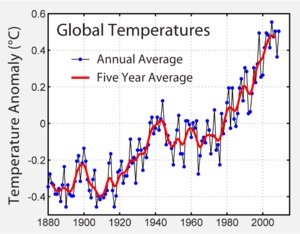Global warming is the increase in the average temperature of the Earth's atmosphere and the world's oceans that has been observed since the 1950s. Climate change is often used as a synonym for global warming. For the period 1906 - 2005, an increase in the average global temperature near the earth's surface by an average of 0.74 ± 0.18 ° C was found.

Average global surface temperature from 1856 to 2005

Average temperature of the Earth's surface from 1980 to 2005
The official opinion of the United Nations Framework Convention on Climate Change (IPCC) is that "most of the increase in global average temperatures observed since the mid-20th century is very likely due to the observed increase in concentrations of anthropogenic greenhouses. gases ". Although some researchers disagree with some of the IPCC's conclusions, according to official information from the same organization, the vast majority of scientists working on climate change agree with the main conclusions.
There are also views that some of the research that suggests that anthropogenic factors are the cause of global warming has been manipulated. According to them, there is evidence that scientists from Europe and North America conducting climate research for nearly 13 years have systematically falsified the data and conclusions about the Earth's climate presented in various reports and scientific articles over the past 2000 years in order to present modern relatively warm climate as a unique phenomenon within the specified period, caused by human activity.
** Observed changes in temperatures**

Diagrams of various reconstructions of temperature changes over the last two thousand years
Evidence of global warming includes the observed increase in global average air and ocean water temperatures, widespread melting of snow and ice, and rising global mean sea levels. The linearly interpolated global average surface temperature increased by 0,74 ± 0,18 ° C for the period 1906-2005, and the warming rate in the second half of this period was almost twice as high as the average for the period as a whole (0, 13 ± 0.03 ° C per decade versus 0.07 ± 0.02 ° C per decade). In these values, the effect of urban heat islands is very small, estimated at less than 0.002 ° C per decade since the beginning of the 20th century. According to satellite temperature measurements, after 1979 the temperature of the lower troposphere increased by between 0.13 and 0.22 ° C per decade. Indirect data show that the temperature for the ten centuries before 1850 was relatively stable, with regional variations such as the Medieval Climate Optimum and the Little Ice Age.
Estimates by the Goddard Space Research Institute and the National Climate Data Center show that 2005 and 2010 were the warmest years since reliable mass measurements began in the late 19th century, ahead of 1998 by several hundredths of a degree. At the same time, according to the Center for Climate Research, 2005 is the second warmest year since 1998 and before 2003 and 2010, which remain in third place, although "the error estimate for the individual years ... is at least ten times higher. large of the differences between these three years. "According to the World Meteorological Organization, the nominal value for 2010 is +0.53 ° C, higher than those for 2005 (+0.52 ° C) and 1998 (+0.51 ° C), although “the differences between them are not statistically significant. "Temperatures in 1998 were unusually high due to the strongest event of the century, the El Niño fluctuation.
Temperature changes in different parts of the world are not the same. Since 1979, land temperatures have risen about twice as fast as those in the ocean, by 0.25 ° C per decade versus 0.13 ° C per decade. The reason for this is the large efficient heat capacity of the oceans and their faster cooling as a result of evaporation. The Northern Hemisphere is warming faster than the Southern Hemisphere, because there the share of land is greater and because of the larger areas of seasonal snow and ice cover, subjected to ice-albedo feedback. Although more greenhouse gases are emitted in the Northern Hemisphere than in the Southern Hemisphere, this does not make a difference, as the main.greenhouse gases have existed long enough to mix in the two hemispheres.
Congratulations @adamlenkov! You have completed the following achievement on the Hive blockchain and have been rewarded with new badge(s) :
Your next target is to reach 200 upvotes.
You can view your badges on your board and compare yourself to others in the Ranking
If you no longer want to receive notifications, reply to this comment with the word
STOP